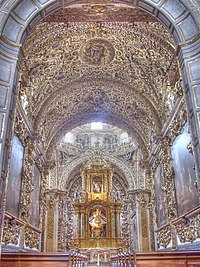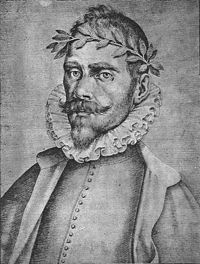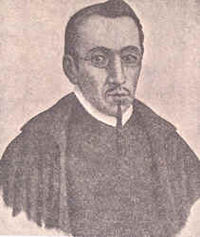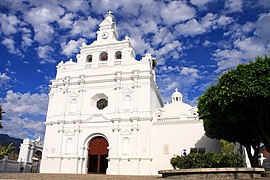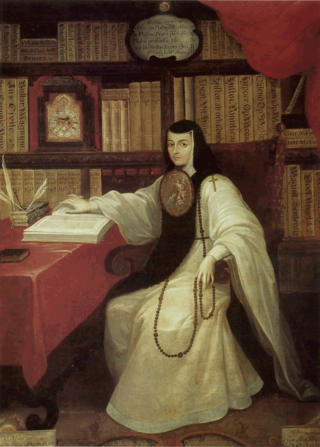
Juana Inés de Asbaje y Ramírez de Santillana, better known as Sor Juana Inés de la Cruz, was a New Spain writer, philosopher, composer and poet of the Baroque period, as well as a Hieronymite nun, nicknamed "The Tenth Muse" and "The Phoenix of America" by her contemporary critics. As a Spanish-criolla from the New Spain, she was among the main American-born contributors to the Spanish Golden Age, alongside Juan Ruiz de Alarcón and Garcilaso de la Vega "el Inca", and is presently considered one of the most important female authors in Spanish language literature and the literature of Mexico.

The Spanish Golden Age was a period that coincided with the political rise of the Spanish Empire under the Catholic Monarchs of Spain and the Spanish Habsburgs. This era saw a flourishing of literature and the arts in Spain. The most significant patron of Spanish art and culture during this time was King Philip II (1556–1598). However, the period is more broadly associated with the reigns of Isabella I, Ferdinand II, Charles V, Philip II, Philip III, and Philip IV, when Spain was at the peak of its power and influence in Europe and the world.

The Basilica Metropolitan Cathedral of Lima and Primate of Peru, otherwise Lima Metropolitan Cathedral, is a Roman Catholic cathedral located in the Plaza Mayor of downtown Lima, Peru. This third and current Cathedral of Lima was built between 1602 and 1797. It is dedicated to St. John, Apostle and Evangelist.

The Metropolitan Cathedral of Morelia is a religious site that is the seat of the Archdiocese of Morelia of the Catholic church in Mexico. It is located as its name itself says in the city of Morelia, capital of the state of Michoacán, Mexico. The cathedral is located in the first square of the city, forming the trace of the Historic Center of Morelia. The building was built in the 18th century at the time of the viceroyalty, it is Baroque in style and is made of pink stone that gives it a peculiar and characteristic color. An important family group headed by Sebastián de Guedea collaborated in its construction for a long period; They were Andrés, Pedro, Diego, Miguel, Anastacio, Lorenzo and Joseph, all with the surname Guedea.
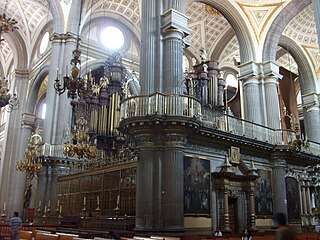
Juan Gutiérrez de Padilla was a Renaissance-style Spanish composer and cantor, most of whose career took place in Mexico.

The Catedral de la Asunción de la Virgen, popularly known as New Cathedral is, together with the Old Cathedral, one of the two cathedrals of Salamanca, Castile and León, Spain. It is the seat of the diocese of Salamanca. It was constructed between 1533 and 1733 mixing late Gothic, Plateresque and Baroque styles. It was commissioned by Ferdinand V of Castile. It is one of the largest cathedrals in Spain in size and its bell tower, at 92 meters high, is also one of the tallest.

Churrigueresque, also but less commonly "Ultra Baroque", refers to a Spanish Baroque style of elaborate sculptural architectural ornament which emerged as a manner of stucco decoration in Spain in the late 17th century and was used until about 1750, marked by extreme, expressive and florid decorative detailing, normally found above the entrance on the main façade of a building.
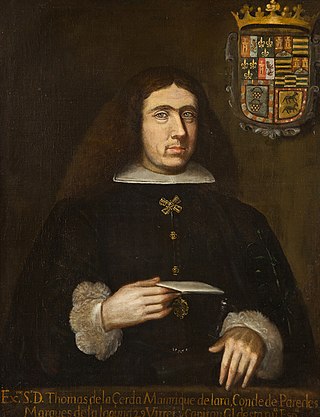
Tomás de la Cerda y Aragón, 3rd Marquess of la Laguna de Camero Viejo, GE, KOA, , was a Spanish nobleman, viceroy of Galicia and of New Spain from 1680 to 1686. He is better known as the Count of Paredes, though he held this title only as consort.

Gaspar de la Cerda Silva Sandoval y Mendoza, 8th Count of Galve, Lord of Salcedón and Tortola was viceroy of New Spain from November 20, 1688, to February 26, 1696.

Don Carlos de Sigüenza y Góngora was one of the first great intellectuals born in the Americas - Spanish viceroyalty of New Spain. He was a criollo patriot, exalting New Spain over Old. A polymath and writer, he held many colonial government and academic positions. Sigüenza is considered the da Vinci mexicano.

The Metropolitan Cathedral of the Assumption of the Most Blessed Virgin Mary into Heaven, also commonly called the Mexico City Metropolitan Cathedral, is the cathedral church of the Catholic Archdiocese of Mexico. It is situated on top of the former Aztec sacred precinct near the Templo Mayor on the northern side of the Plaza de la Constitución (Zócalo) in the historic center of Mexico City. The cathedral was built in sections from 1573 to 1813 around the original church that was constructed soon after the Spanish conquest of Tenochtitlan, eventually replacing it entirely. Spanish architect Claudio de Arciniega planned the construction, drawing inspiration from Gothic cathedrals in Spain.

The Basilica Cathedral of Puebla, as the Cathedral of Our Lady of the Immaculate Conception is known according to its Marian invocation, is the episcopal see of the Archdiocese of Puebla de los Ángeles (Mexico). It is one of the most important buildings in the historic center of Puebla declared a World Heritage Site by UNESCO. It has the prerogative of being the first sumptuous temple that under fine architectural designs was built in the Americas, consecrated in 1649, ahead of the Metropolitan of Mexico that was dedicated in 1653. It was founded by Philip II of Spain.
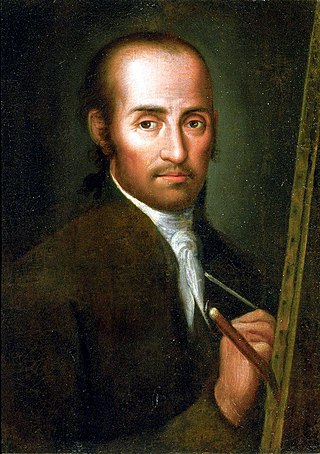
José de Ibarra (1688–1756) was a New Spanish painter. He was born in Guadalajara, Mexico in 1688, and died November 21, 1756, in Mexico City, in the Viceroyalty of New Spain. Ibarra was a disciple of the distinguished painter Juan Correa (1646-1716), whose parents were of Afro-Moorish Afro-Mexican descent. José de Ibarra is, along with Juan Rodríguez Juárez (1675-1728), one of the most prominent figures in painting from the first half of the 18th century in New Spain, modern day's Mexico. A follower of the artistic renewal promoted by the brothers Juan and Nicolás Rodríguez Juárez, in whose workshop he collaborated, Ibarra cultivated in his work the language of pictorial modernism with strong Italian and French influences. This would be the direct antecedent of the work of Miguel Cabrera (1715-1768), whose fame would eclipse that of which Ibarra himself enjoyed among his contemporaries as a brush artist.

Cristóbal de Villalpando was a Baroque Criollo artist from New Spain, arts administrator and captain of the guard. He painted prolifically and produced many Baroque works now displayed in several Mexican cathedrals, including the cathedrals in Querétaro and Mexico City, as well as a depiction of the Zócalo in Mexico City, showing the damage of the 1692 riot to the viceregal palace three years earlier.

Juan Correa (1646–1716) was a distinguished Mexican painter of the late seventeenth and early eighteenth centuries. His years of greatest activity were from 1671 to 1716.

The architecture of Mexico reflects the influences of various cultures, regions, and periods that have shaped the country's history and identity. In the pre-Columbian era, distinct styles emerged that reflected the distinct cultures of the indigenous peoples of Mexico, particularly in the architecture of Mesoamerica. During the colonial era, the region was transformed by successive styles from Europe. With the foremost style during this era being Mexican Baroque.

Simon Pereyns was a Flemish painter. He moved to Lisbon, Portugal in 1558 and later to Madrid, Spain. In 1566, he moved to Mexico where he gained fame as a painter of numerous works, most of which have not survived. He created the altarpiece of Huejotzingo at the Franciscan convent of Huejotzingo in Puebla, Mexico, one of the monasteries on the slopes of Popocatépetl. Included in his works is a depiction of Saint Christopher.
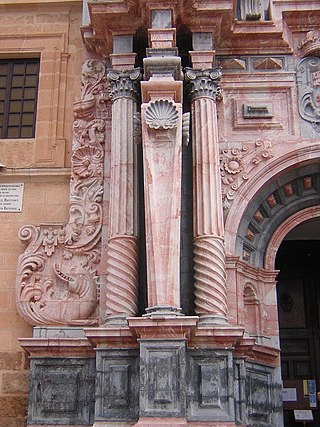
The estipite column is a type of pilaster typical of the Churrigueresque Baroque style of Spain and Spanish America used in the 18th century. In the late Baroque period, many classical architectural elements lost their simple shapes and became increasingly complex, offering variety of forms and exuberant decoration. Therefore, the column has the shape of an inverted cone or obelisk. The shaft is always wider in its middle part than the base and capital. The column combines features of both late Baroque and Mannerist. It was widely used between 1720 and 1780.

The Parroquia de Santa Prisca y San Sebastían, commonly known as the Church of Santa Prisca, is a colonial monument located in the city of Taxco de Alarcón, in the southern state of Guerrero, Mexico, built between 1751 and 1759. It is located on the east side of the main plaza of Taxco.

Los empeños de una casa is one of Sor Juana Inés de la Cruz's dramatic literary pieces. It was first performed on October 4, 1683, during the birthday celebrations held for the first-born child of the Viceroy Count of Paredes; of which coincided with the entry of the new archbishop of Mexico City, Francisco de Aguiar y Seijas.

